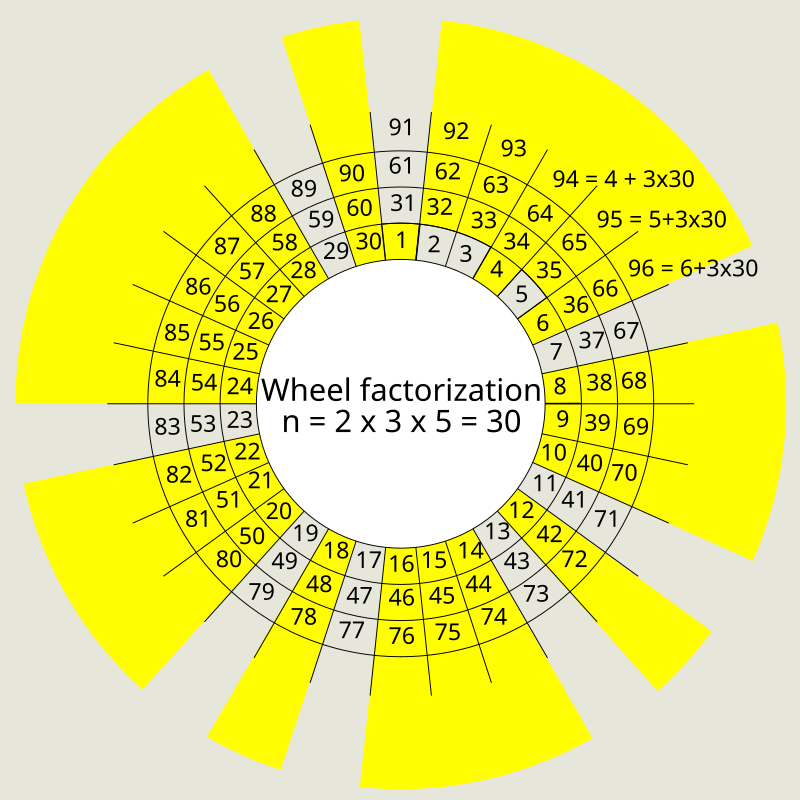Given a number N. The task is to check if the given number is Prime Number or not.
Examples:
Input: N = 987
Output: Not a Prime Number
Explanation:
As, 987 = 3*7*47. Therefore 987 is not a prime number.
Input: N = 67
Output: Prime Number
Wheel Factorization Method:
Wheel Factorization is the improvement of the method Sieve of Eratosthenes. For wheel factorization, one starts from a small list of numbers, called the basis — generally the first few prime numbers, then one generates the list, called the wheel, of the integers that are coprime with all numbers of the basis. Then to find the smallest divisor of the number to be factorized, one divides it successively by the numbers on the basis, and in the wheel.
Let say we select basis as {2, 3, 5} and the numbers which are coprime to the basis are {7, 11, 13, 17, 19, 23, 29, 31} are set as the wheel.
To understand it more, see the pattern in the above image that the numbers exhibit. The LCM of the first three Prime Numbers is 30. The numbers(less than 30) which are ending with 7, 1, and 3 and are not a multiple of 2, 3, and 5 and are always prime i.e {7, 11, 13, 17, 19, 23, 29}. Adding the no. 31 to this list and then if we add multiples of 30 to any of the numbers in the list, it gives us a Prime Number.
Algorithm for Wheel Factorization Method:
For the number N to be Prime or not:
bool isPrime(x) {
if (x < 2) {
return False;
}
for N in {2, 3, 5} {
return False;
}
for p= [0, sqrt(N)] such that p = p + 30: {
for c in [p+7, p+11, p+13, p+17, p+19, p+23, p+29, p+31] {
if c > sqrt(N)
break;
else if N % (c+p) = 0:
return False;
}
}
}
return True;
}
Approach:
Following is the approach for the above algorithm:
- For Primality Test of a given Number N, check if the given number is divisible by any of the number 2, 3, 5 or not.
- If the number is not divisible by any of 2, 3, 5, then check if the number formed by adding multiples of 30 in the list [7, 11, 13, 17, 19, 23, 29, 31] divides the given number N or not. If Yes then the given number is not Prime Number, else it is a Prime Number.
Below is the implementation of the above approach:
C++
// C++ program to check if the// given number is prime using// Wheel Factorization Method#include "bits/stdc++.h"using namespace std;// Function to check if a given// number x is prime or notvoid isPrime(int N){ bool isPrime = true; // The Wheel for checking // prime number int arr[8] = { 7, 11, 13, 17, 19, 23, 29, 31 }; // Base Case if (N < 2) { isPrime = false; } // Check for the number taken // as basis if (N % 2 == 0 || N % 3 == 0 || N % 5 == 0) { isPrime = false; } // Check for Wheel // Here i, acts as the layer // of the wheel for (int i = 0; i < sqrt(N); i += 30) { // Check for the list of // Sieve in arr[] for (int c : arr) { // If number is greater // than sqrt(N) break if (c > sqrt(N)) { break; } // Check if N is a multiple // of prime number in the // wheel else { if (N % (c + i) == 0) { isPrime = false; break; } } // If at any iteration // isPrime is false, // break from the loop if (!isPrime) break; } } if (isPrime) cout << "Prime Number"; else cout << "Not a Prime Number";}// Driver's Codeint main(){ int N = 121; // Function call for primality // check isPrime(N); return 0;} |
Java
// Java program to check if the// given number is prime using// Wheel Factorization Methodimport java.util.*;class GFG{// Function to check if a given// number x is prime or notstatic void isPrime(int N){ boolean isPrime = true; // The Wheel for checking // prime number int []arr = { 7, 11, 13, 17,19, 23, 29, 31 }; // Base Case if (N < 2) { isPrime = false; } // Check for the number taken // as basis if (N % 2 == 0 || N % 3 == 0 || N % 5 == 0) { isPrime = false; } // Check for Wheel // Here i, acts as the layer // of the wheel for (int i = 0; i < Math.sqrt(N); i += 30) { // Check for the list of // Sieve in arr[] for (int c : arr) { // If number is greater // than sqrt(N) break if (c > Math.sqrt(N)) { break; } // Check if N is a multiple // of prime number in the // wheel else { if (N % (c + i) == 0) { isPrime = false; break; } } // If at any iteration // isPrime is false, // break from the loop if (!isPrime) break; } } if (isPrime) System.out.println("Prime Number"); else System.out.println("Not a Prime Number");}// Driver's Codepublic static void main(String args[]){ int N = 121; // Function call for primality // check isPrime(N);}}// This code is contributed by Surendra_Gangwar |
C#
// C# program to check if the// given number is prime using// Wheel Factorization Methodusing System;class GFG{// Function to check if a given// number x is prime or notstatic void isPrime(int N){ bool isPrime = true; // The Wheel for checking // prime number int []arr = { 7, 11, 13, 17,19, 23, 29, 31 }; // Base Case if (N < 2) { isPrime = false; } // Check for the number taken // as basis if (N % 2 == 0 || N % 3 == 0 || N % 5 == 0) { isPrime = false; } // Check for Wheel // Here i, acts as the layer // of the wheel for (int i = 0; i < (int)Math.Sqrt(N); i += 30) { // Check for the list of // Sieve in arr[] foreach (int c in arr) { // If number is greater // than sqrt(N) break if (c > (int)Math.Sqrt(N)) { break; } // Check if N is a multiple // of prime number in the // wheel else { if (N % (c + i) == 0) { isPrime = false; break; } } // If at any iteration // isPrime is false, // break from the loop if (!isPrime) break; } } if (isPrime) Console.WriteLine("Prime Number"); else Console.WriteLine("Not a Prime Number");}// Driver's Codepublic static void Main(String []args){ int N = 121; // Function call for primality // check isPrime(N);}}// This code is contributed by Yash_R |
Python3
# Python3 program to check if the# given number is prime using# Wheel Factorization Methodimport math# Function to check if a given# number x is prime or notdef isPrime( N): isPrime = True; # The Wheel for checking # prime number arr= [ 7, 11, 13, 17, 19, 23, 29, 31 ] # Base Case if (N < 2) : isPrime = False # Check for the number taken # as basis if (N % 2 == 0 or N % 3 == 0 or N % 5 == 0): isPrime = False # Check for Wheel # Here i, acts as the layer # of the wheel for i in range(0,int(math.sqrt(N)), 30) : # Check for the list of # Sieve in arr[] for c in arr: # If number is greater # than sqrt(N) break if (c > int(math.sqrt(N))): break # Check if N is a multiple # of prime number in the # wheel else : if (N % (c + i) == 0) : isPrime = False break # If at any iteration # isPrime is false, # break from the loop if (not isPrime): break if (isPrime): print("Prime Number") else: print("Not a Prime Number")# Driver's Codeif __name__ == "__main__": N = 121 # Function call for primality # check isPrime(N)# This code is contributed by chitranayal |
Javascript
<script>// JavaScript program to check if the// given number is prime using// Wheel Factorization Method// Function to check if a given// number x is prime or notfunction isPrime(N){ let isPrime = true; // The Wheel for checking // prime number let arr = [ 7, 11, 13, 17, 19, 23, 29, 31 ]; // Base Case if (N < 2) { isPrime = false; } // Check for the number taken // as basis if (N % 2 == 0 || N % 3 == 0 || N % 5 == 0) { isPrime = false; } // Check for Wheel // Here i, acts as the layer // of the wheel for (let i = 0; i < Math.sqrt(N); i += 30) { // Check for the list of // Sieve in arr[] for (let c of arr) { // If number is greater // than sqrt(N) break if (c > Math.sqrt(N)) { break; } // Check if N is a multiple // of prime number in the // wheel else { if (N % (c + i) == 0) { isPrime = false; break; } } // If at any iteration // isPrime is false, // break from the loop if (!isPrime) break; } } if (isPrime) document.write("Prime Number"); else document.write("Not a Prime Number");}// Driver's Code let N = 121; // Function call for primality // check isPrime(N); // This code is contributed by _saurabh_jaiswal </script> |
Not a Prime Number
Time Complexity: O(N3/2)
Auxiliary Space: O(1)
Ready to dive in? Explore our Free Demo Content and join our DSA course, trusted by over 100,000 neveropen!





